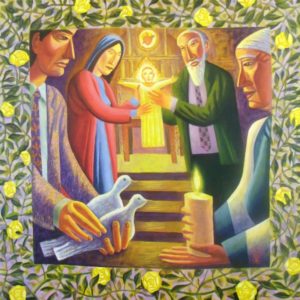The Presentation, James P. Jankneght
Mount Calvary Church
Eutaw Street and Madison Avenue
Baltimore, Maryland
A Roman Catholic Parish of
The Personal Ordinariate of St. Peter
Anglican Use
Rev. Albert Scharbach, Pastor
Dr. Allen Buskirk, Choirmaster
Midori Ataka, Organist
The Presentation of Jesus in the Temple
Candlemas
Sunday, February 2, 2020
8:00 AM Said Mass
10:00 AM Sung Mass
Blessing of Candles
Procession with Candles
Brunch to follow in undercroft
___________________
Common
Mass for Three Voices, William Byrd
______________
Organ Prelude
Fugue and Harmonization on “St. Anne”; Adapted by Hal Hopson
__________
Organ Postlude
Toccata, by Girolamo Frescobaldi
__________________
Anthems
Diffusa est gratia, William Byrd (1540-1623)
Diffusa est gratia in labiis tuis: propterea benedixit te Deus in aeternum. Propter veritatem et mansuetudinem et justitiam: et deducet te mirabiliter dextera tua. Audi filia, et vide, et inclina aurem tuam: quia concupivit Rex speciem tuam.
Grace is poured abroad in thy lips: therefore hath God blessed thee for ever. Because of truth, and mildness, and justice: and thy right hand shall conduct thee marvelously. Hear, daughter, and see, and incline thine ear, for the king hath coveted thy beauty.
_________
Ave verum corpus, William Byrd (1540-1623)
Ave verum corpus natum ex Maria virgine, vere passum immolatum in cruce pro homine, cuius latus perforatum unda fluxit sanguine, esto nobis praegustatum mortis in examine. O dulcis, o pie, o Jesu, fili Mariae, miserere mei.
Hail, true Body, born of the Virgin Mary, who having truly suffered, was sacrificed on the cross for mankind, whose pierced side flowed with water and blood: May it be for us a foretaste [of the Heavenly banquet] in the trial of death. O sweet, O gentle, O Jesu, son of Mary, have mercy on me.
_________________
Hymns
#115 Hail to the Lord who comes (OLD HUNDRED TWENTIETH) was written by the Anglican clergyman John Ellerton (1826–1893). The first verse contains a series of negatives: this is not the eschatological Christ in glory, nor the one entering Jerusalem on Palm Sunday. But in the second verse the secret is disclosed: the Lord is an infant. Here Ellerton imaginatively reinterprets Luke’s story. Mary’s breast is Christ’s earthly throne and the infant Saviour is now a guest, albeit a heavenly guest, in his Father’s earthly house. The third verse is not unlike an Italian Renaissance painting rendered into words, but towards the end of the verse the mention of Simeon recalls the ‘Nunc dimittis.’
#20 Of the father’s love begotten is a translation of corde natus ex parentis by Aurelius Clemens Prudentius (ca. 348-ca. 413) by Sir Henry Williams Baker (1821-1877) based on one by John Mason Neale (1818-1866).
In His temple now behold him was written by Henry John Pye (1827-1903), who was ordained as an Anglican clergyman but with his family entered the Roman Catholic Church in 1868. The tune ST THOMAS, often used for the Tantum ergo, is attributed to Samuel Webbe (1740-1816).
Born in Menorca in 1740, Webbe was brought up in London. His father died when he was still an infant, and his mother returned to London where she raised Webbe in difficult circumstances. At the age of 11 he was apprenticed to a cabinet maker, and during the first year of his apprenticeship his mother died.
Webbe was an autodidact. He first discovered his aptitude for music when called on to repair the case of a harpsichord. During the course of the repair work he taught himself to play the instrument. Near the end of the job he was overheard playing it. As a result of this incident he turned to the study of music under Carl Barbandt.
A Roman Catholic, Webbe in 1776 became organist of the Sardinian Embassy Chapel, a position which he held until 1795; he was also organist and choirmaster of chapel of the Portuguese Embassy in Lincoln’s Inn Fields, the only place in London where the Catholic liturgy could be publicly celebrated.
